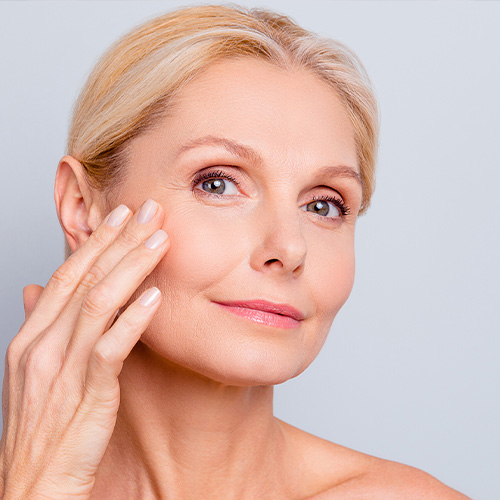Metvix Photodynamic Therapy is a non-invasive, in-office procedure that treats multiple pre-cancerous and cancerous lesions found on the surface of the skin. This treatment consists of the application of a topical cream (Metvix), followed by light exposure to selectively target and destroy the atypical skin cells.
Get The Facts
Metvix Photodynamic Therapy is Health Canada-approved to treat one of the most common types of skin cancer (superficial basal cell carcinoma) and actinic keratoses, which are lesions caused by sun damage that can turn into cancer. The Metvix (methyl aminolevulinate cream) will only react with the targeted skin cells, while the surrounding healthy skin cells receive minimal to no reaction from the treatment. The number of treatments depends on the severity of the condition; however, an average of two treatments is typical, spaced 1-6 months apart. Additional maintenance treatments are required in some cases.

Before you Arrive:
+ Please ensure you have filled out your Health History/Intake form before your appointment. If you are unable to complete it, please arrive 15 minutes early
+ Inform your provider if you have a nut allergy (especially peanuts and/or almonds)
+ Please let us know if you have a history of cold sores so we can arrange for a prophylactic antiviral medication before treatment
How to Prepare:
+ Tylenol may be taken before the appointment for pain management
+ We recommend you bring protective clothing (wide-brimmed hat, sunglasses, long sleeves, etc.) to protect your treated skin from the sun after your treatment
What to avoid:
We recommend avoiding the following:
+ UV exposure for 2 weeks prior
+ Applying exfoliants or actives such as AHA/BHAs, Retinol, Hydroquinone, Benzyl Peroxide, etc. for at least 2 weeks prior
+ Waxing or shaving the treatment area 5 days prior
+ Is it our policy to not provide treatment if you are pregnant or breastfeeding
Downtime:
+ Redness, swelling, flaking, peeling, and sometimes blistering of the treated area(s) is expected in the 7-10 days following treatment
+ In very sensitive skin, mild irritation can last up to 4 weeks
What to Avoid:
+ Complete exposure to UV light for 48 hours (the light may reactivate the medication and cause further irritation)
+ Excessive exposure to heat (hot tubs, saunas, steam rooms) for at least 7 days
+ Applying actives (AHA/BHAs, Retinol, Hydroquinone, Benzyl Peroxide, etc.) to treated area(s) for at least 7 days, depending on skin sensitivity
+ No laser treatments for at least 4-6 weeks
Follow Up:
+ Maintenance treatments may be required for re-occurring or new sun damage
+ Daily sun protection, at least SPF 30
+ Skin Cancer Prevention
+ Actinic keratoses (AKs)
+ Superficial Basal Cell Carcinoma
Redness, swelling, flaking, peeling and sometimes blistering of the treated area(s) is expected in the week following treatment. Patients must completely avoid UV light for 48 hours post-treatment; Broad-spectrum sunscreen is not enough protection from UV rays 48 hrs post-treatment.
Many patients report mild-moderate stinging or burning sensations during treatment. Our technicians will use a fan to increase comfort and cooling during treatment. It may also be beneficial to take an over-the-counter analgesic 1 hour before treatment.
The Metfix cream can be reimbursed through third-party insurance companies. For specific details on coverage, contact your insurance company as well as visit us for a complimentary consult to determine the course necessary for reimbursement.
Methyl Aminolevulinate is a photosensitizing drug, meaning it will make your skin more sensitive to light. When exposed to certain types of light, it will create a reaction that will destroy certain types of abnormal, cancerous skin cells. You should not use Methyl Aminolevulinate if you are allergic to porphyrins, peanuts, or almonds, or if your skin is extremely sensitive to light.
Before the Metfix cream is applied, a nurse will gently scrape the targeted skin lesions to remove any extra crusting to make the treatment more effective. The cream is left on the skin for 2.5 – 3 hours, followed by light therapy with a medical aesthetician to activate the Metvix cream.
While any time will be beneficial to receive the treatment, avoiding Metfix Photodynamic Therapy in the summer months may be optimal to avoid any UV exposure pre and post-treatment to decrease the risk of unwanted side effects.
Terms and conditions apply.
Follow our socials to stay up-to-date.